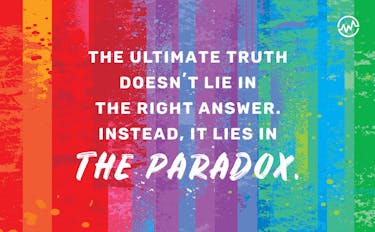
Developing a Millionaire Mindset
How to Develop the Mental Models that Lead to 7-Figure Income
In This Article
There is another mindset that’s more open, flexible, and accommodating. It’s a perspective that’s suited to dealing with uncertainty, complexity and change.
And it’s a way of thinking that never has the right answer, but can always find a solution.
This perspective is called grayscale thinking.
Stages of Adult Development
Robert Kegan, psychologist and professor at Harvard, is the founder of adult development theory. The theory describes how people mature and grow into adulthood. There are five stages:

We like answers. They provide us with a sense of certainty and control. In the pursuit of clear answers, we filter and compartmentalize, separating right from wrong. We see the world in black and white. But that’s not the only way to see the world.
For a self-transforming mind, there is no black and white.
There are no firm answers.
Everything is just a different shade of gray.
“People with this form of mind are less likely to see the world in terms of dichotomies or polarities,” Jennifer Garvey Berger, long-time collaborator of Robert Kegan, explains.
“They are more likely to believe that what we often think of as black and white are just various shades of gray whose differences are made more visible by the lighter or darker colors around them."
Learn To Appreciate The Subtle Details
Not striving to find the right answer can sound like heresy in a rational, left-brain dominated world.
Finding the right solutions is something so integrated into the modern mind that it can seem pointless—impossible even—to consider other ways of operating.
But this obsession of having the right answer is only one way of viewing the world.
Grayscale thinking is a perspective of nuances.
It’s about finding the exceptions.
It’s dancing in the spaces between, of playing with the boundaries themselves.
Rather than focusing on finding the right answer, it’s about uncovering newer and better questions.
If we follow questions, one answer will never be enough. More nuance and subtlety always lies in store. And with that, even better answers, and even greater questions, emerge.
Scott Cook, founder of Intuit, describes in the book Trillion Dollar Coach the mindset of legendary CEO and leadership coach Bill Campbell.
Cook tells the story of how, when interviewing Campbell for a role at Intuit, the power of Campbell’s grayscale thinking became apparent.
“The first time we met, we talked about business and strategy," Cook says. "But when we talked again, we got off of strategy and talked instead about leadership and people. The other people I had interviewed had a cookie-cutter approach to developing people. You can have any color you want as long as it's black. But Bill, he was a technicolor rainbow.”
He continued: “He appreciated that each person had a different story and background. He was so nuanced and different in how he approached growth challenges and leadership challenges … Bill was great at that."
How to Spot the Difference
There are a few signs that you’re entering into black-and-white territory.
Anytime you make a statement of “this is how things work”, you are making a black-and-white statement.
When you notice yourself using words like “must,” “should,” “always”, and “never”, you are entering the realm of black-and-white.
Grayscale thinking has a different vocabulary. It’s peppered with “maybes” and “sometimes”.
Phrases like “on the one hand . . . on the other hand“ show up time and again.
It’s a constant process of exploration, of twisting and turning, and remaining curious.
A black-and-white thinker will ask, “Is this true?”. A gray-scale thinker asks, “How could this be true?”
You don't need to always avoid absolutes. The key is to be aware that you’re entering into dangerous territory if you do.
Proceed far enough, and you’re turning off access to other realities.
Paul Saffo, technology forecaster and professor at Stanford University, is famous for coining the term “strong beliefs, loosely held.” This is compatible with grayscale thinking.
Strong opinions are essential—as long as they’re held with enough objectivity that you can update them when required.
If you’re a grayscale thinker, your identity and sense of self-worth are not tied up with your opinions. Instead, you’re always seeking a greater and deeper truth.
This continuous exercise demands not only letting go of your identity, but also a willingness to update your current beliefs and worldview.
Grayscale thinkers don’t just look through their worldview.
They look at it.
Instead of taking for granted the world they see through their glasses, they observe and scrutinize the glasses themselves.
Finding Color and Truth in the Paradoxes

It’s when we’re posed with the most confusing, contradictory, irreconcilable challenges that truths emerge.
It is in grappling with that we understand.
It is in the struggle to grasp that we are made.
“When things are most contradictory, absurd, difficult and frustrating,” writes E. F. Schumacher, “then—just then—life really makes sense.”
There is no right. There is no wrong. There is only more or less.
It’s all a following of questions, of challenges. And in your pursuit of these questions, you probably won’t receive an answer. You’re more likely to receive yet another question.
And another. And another.
This may seem frustrating. But this is living.
Rigidity, static, fixed is death. Complexity, challenge, confusion is aliveness.
It’s in the tension where dynamism and vibrance lives. It’s in the electric energy where the thrill of adventure occurs. It’s in the contradictions, in the variations, where the fullness of life is experienced.
Black and white is decay.
Grayscale is aliveness.
Grayscale is a life in color.






